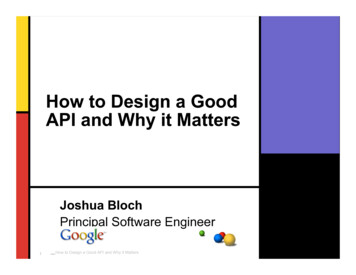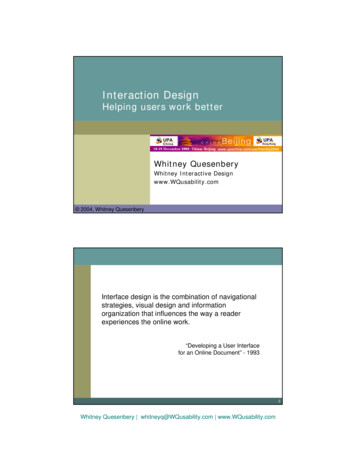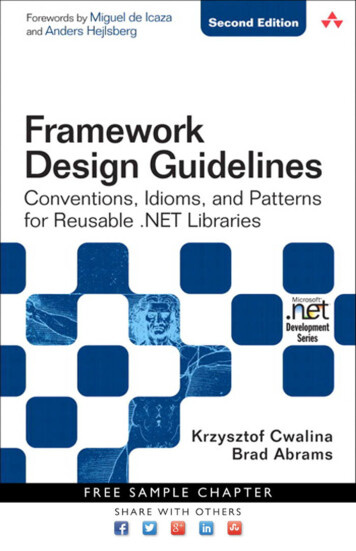
Transcription
How to Design a GoodAPI and Why it MattersJoshua BlochPrincipal Software Engineer1How to Design a Good API and Why it Matters
Why is API Design Important? APIs can be among a company's greatest assetsCustomers invest heavily: buying, writing, learningCost to stop using an API can be prohibitiveSuccessful public APIs capture customers Can also be among company's greatest liabilitiesBad APIs result in unending stream of support calls Public APIs are forever - one chance to get it right2How to Design a Good API and Why it Matters
Why is API Design Important to You? If you program, you are an API designerGood code is modular–each module has an API Useful modules tend to get reusedOnce module has users, can’t change API at willGood reusable modules are corporate assets Thinking in terms of APIs improves code quality3How to Design a Good API and Why it Matters
Characteristics of a Good API 4Easy to learnEasy to use, even without documentationHard to misuseEasy to read and maintain code that uses itSufficiently powerful to satisfy requirementsEasy to extendAppropriate to audienceHow to Design a Good API and Why it Matters
OutlineI. The Process of API DesignII. General PrinciplesIII. Class DesignIV. Method DesignV. Exception DesignVI. Refactoring API Designs5How to Design a Good API and Why it Matters
I. The Process of API Design6How to Design a Good API and Why it Matters
Gather Requirements–with a HealthyDegree of Skepticism Often you'll get proposed solutions insteadBetter solutions may exist Your job is to extract true requirementsShould take the form of use-cases Can be easier and more rewarding to buildsomething more generalGood7How to Design a Good API and Why it Matters
Start with Short Spec–1 Page is Ideal At this stage, agility trumps completeness Bounce spec off as many people as possibleListen to their input and take it seriously If you keep the spec short, it’s easy to modify Flesh it out as you gain confidenceThis necessarily involves coding8How to Design a Good API and Why it Matters
Write to Your API Early and Often Start before you've implemented the APISaves you doing implementation you'll throw away Start before you've even specified it properlySaves you from writing specs you'll throw away Continue writing to API as you flesh it outPrevents nasty surprisesCode lives on as examples, unit tests9How to Design a Good API and Why it Matters
Writing to SPI is Even More Important Service Provider Interface (SPI)Plug-in interface enabling multiple implementationsExample: Java Cryptography Extension (JCE) Write multiple plug-ins before releaseIf you write one, it probably won't support anotherIf you write two, it will support more with difficultyIf you write three, it will work fine Will Tracz calls this “The Rule of Threes”(Confessions of a Used Program Salesman, Addison-Wesley, 1995)Bad10How to Design a Good API and Why it Matters
Maintain Realistic Expectations Most API designs are over-constrainedYou won't be able to please everyoneAim to displease everyone equally Expect to make mistakesA few years of real-world use will flush them outExpect to evolve API11How to Design a Good API and Why it Matters
II. General Principles12How to Design a Good API and Why it Matters
API Should Do One Thing and Do it Well Functionality should be easy to explainIf it's hard to name, that's generally a bad signGood names drive developmentBe amenable to splitting and merging modules13How to Design a Good API and Why it Matters
API Should Be As Small As Possible ButNo Smaller API should satisfy its requirements When in doubt leave it outFunctionality, classes, methods, parameters, etc.You can always add, but you can never remove Conceptual weight more important than bulk Look for a good power-to-weight ratio14How to Design a Good API and Why it Matters
Implementation Should Not Impact API Implementation detailsConfuse usersInhibit freedom to change implementation Be aware of what is an implementation detailDo not overspecify the behavior of methodsFor example: do not specify hash functionsAll tuning parameters are suspect Don't let implementation details “leak” into APIOn-disk and on-the-wire formats, exceptions15How to Design a Good API and Why it Matters
Minimize Accessibility of Everything Make classes and members as private as possible Public classes should have no public fields(with the exception of constants) This maximizes information hiding Allows modules to be used, understood, built,tested, and debugged independently16How to Design a Good API and Why it Matters
Names Matter–API is a Little Language Names Should Be Largely Self-ExplanatoryAvoid cryptic abbreviations Be consistent–same word means same thingThroughout API, (Across APIs on the platform) Be regular–strive for symmetry Code should read like proseif (car.speed() 2 * SPEED LIMIT)generateAlert("Watch out for cops!");17How to Design a Good API and Why it Matters
Documentation MattersReuse is something that is far easier to say thanto do. Doing it requires both good design andvery good documentation. Even when we seegood design, which is still infrequently, we won'tsee the components reused without gooddocumentation.- D. L. Parnas, Software Aging. Proceedingsof 16th International Conference SoftwareEngineering, 199418How to Design a Good API and Why it Matters
Document Religiously Document every class, interface, method,constructor, parameter, and exceptionClass: what an instance representsMethod: contract between method and its clientPreconditions, postconditions, side-effectsParameter: indicate units, form, ownership Document state space very carefully19How to Design a Good API and Why it Matters
Consider Performance Consequences ofAPI Design Decisions Bad decisions can limit performanceMaking type mutableProviding constructor instead of static factoryUsing implementation type instead of interface Do not warp API to gain performanceUnderlying performance issue will get fixed,but headaches will be with you foreverGood design usually coincides with good performance20How to Design a Good API and Why it Matters
Effects of API Design Decisions onPerformance are Real and Permanent Component.getSize() returns Dimension Dimension is mutable Each getSize call must allocate Dimension Causes millions of needless object allocations Alternative added in 1.2; old client code still slow21How to Design a Good API and Why it Matters
API Must Coexist Peacefully with Platform Do what is customaryObey standard naming conventionsAvoid obsolete parameter and return typesMimic patterns in core APIs and language Take advantage of API-friendly featuresGenerics, varargs, enums, default arguments Know and avoid API traps and pitfallsFinalizers, public static final arrays22How to Design a Good API and Why it Matters
III. Class Design23How to Design a Good API and Why it Matters
Minimize Mutability Classes should be immutable unless there’s agood reason to do otherwiseAdvantages: simple, thread-safe, reusableDisadvantage: separate object for each value If mutable, keep state-space small, well-definedMake clear when it's legal to call which methodBad: Date, CalendarGood: TimerTask24How to Design a Good API and Why it Matters
Subclass Only Where It Makes Sense Subclassing implies substitutability (Liskov)Subclass only when is-a relationship existsOtherwise, use composition Public classes should not subclass other publicclasses for ease of implementationBad:Properties extends HashtableStack extends VectorGood: Set extends Collection25How to Design a Good API and Why it Matters
Design and Document for Inheritanceor Else Prohibit it Inheritance violates encapsulation (Snyder, ‘86)Subclass sensitive to implementation details ofsuperclass If you allow subclassing, document self-useHow do methods use one another? Conservative policy: all concrete classes finalBad: Many concrete classes in J2SE librariesGood: AbstractSet, AbstractMap26How to Design a Good API and Why it Matters
IV. Method Design27How to Design a Good API and Why it Matters
Don't Make the Client Do Anything theModule Could Do Reduce need for boilerplate codeGenerally done via cut-and-pasteUgly, annoying, and nsform.dom.*;javax.xml.transform.stream.*;// DOM code to write an XML document to a specified output stream.private static final void writeDoc(Document doc, OutputStream out)throws IOException{try {Transformer t t.setOutputProperty(OutputKeys.DOCTYPE SYSTEM, doc.getDoctype().getSystemId());t.transform(new DOMSource(doc), new StreamResult(out));} catch(TransformerException e) {throw new AssertionError(e); // Can’t happen!}}28How to Design a Good API and Why it Matters
Don't Violate the Principle of LeastAstonishment User of API should not be surprised by behaviorIt's worth extra implementation effortIt's even worth reduced performancepublic class Thread implements Runnable {// Tests whether current thread has been interrupted.// Clears the interrupted status of current thread.public static boolean interrupted();}29How to Design a Good API and Why it Matters
Fail Fast–Report Errors as Soon asPossible After They Occur Compile time is best - static typing, generics At runtime, first bad method invocation is bestMethod should be failure-atomic// A Properties instance maps strings to stringspublic class Properties extends Hashtable {public Object put(Object key, Object value);// Throws ClassCastException if this properties// contains any keys or values that are not stringspublic void save(OutputStream out, String comments);}30How to Design a Good API and Why it Matters
Provide Programmatic Access to AllData Available in String Form Otherwise, clients will parse stringsPainful for clientsWorse, turns string format into de facto APIpublic class Throwable {public void printStackTrace(PrintStream s);public StackTraceElement[] getStackTrace(); // Since 1.4}public final class StackTraceElement {public String getFileName();public int getLineNumber();public String getClassName();public String getMethodName();public boolean isNativeMethod();}31How to Design a Good API and Why it Matters
Overload With Care Avoid ambiguous overloadingsMultiple overloadings applicable to same actualsConservative: no two with same number of args Just because you can doesn't mean you shouldOften better to use a different name If you must provide ambiguous overloadings,ensure same behavior for same argumentspublic TreeSet(Collection c); // Ignores orderpublic TreeSet(SortedSet s); // Respects order32How to Design a Good API and Why it Matters
Use Appropriate Parameter and Return Types Favor interface types over classes for inputProvides flexibility, performance Use most specific possible input parameter typeMoves error from runtime to compile time Don't use string if a better type existsStrings are cumbersome, error-prone, and slow Don't use floating point for monetary valuesBinary floating point causes inexact results! Use double (64 bits) rather than float (32 bits)Precision loss is real, performance loss negligible33How to Design a Good API and Why it Matters
Use Consistent Parameter OrderingAcross Methods Especially important if parameter types identical#include string.h char *strcpy (char *dest, char *src);void bcopy(void *src, void *dst, int n);java.util.Collections – first parameter alwayscollection to be modified or queriedjava.util.concurrent – time always specified aslong delay, TimeUnit unit34How to Design a Good API and Why it Matters
Avoid Long Parameter Lists Three or fewer parameters is idealMore and users will have to refer to docs Long lists of identically typed params harmfulProgrammers transpose parameters by mistakePrograms still compile, run, but misbehave! Two techniques for shortening parameter listsBreak up methodCreate helper class to hold parameters// Eleven parameters including four consecutive intsHWND CreateWindow(LPCTSTR lpClassName, LPCTSTR lpWindowName,DWORD dwStyle, int x, int y, int nWidth, int nHeight,HWND hWndParent, HMENU hMenu, HINSTANCE hInstance,LPVOID lpParam);35How to Design a Good API and Why it Matters
Avoid Return Values that DemandExceptional Processing return zero-length array or empty collection, not nullpackage java.awt.image;public interface BufferedImageOp {// Returns the rendering hints for this operation,// or null if no hints have been set.public RenderingHints getRenderingHints();}36How to Design a Good API and Why it Matters
V. Exception Design37How to Design a Good API and Why it Matters
Throw Exceptions to IndicateExceptional Conditions Don’t force client to use exceptions for control flowprivate byte[] a new byte[BUF SIZE];void processBuffer (ByteBuffer buf) {try {while (true) {buf.get(a);processBytes(tmp, BUF SIZE);}} catch (BufferUnderflowException e) {int remaining buf.remaining();buf.get(a, 0, remaining);processBytes(bufArray, remaining);}} Conversely, don’t fail silentlyThreadGroup.enumerate(Thread[] list)38How to Design a Good API and Why it Matters
Favor Unchecked Exceptions Checked – client must take recovery action Unchecked – programming error Overuse of checked exceptions causes boilerplatetry {Foo f (Foo) super.clone();.} catch (CloneNotSupportedException e) {// This can't happen, since we’re Cloneablethrow new AssertionError();}39How to Design a Good API and Why it Matters
Include Failure-Capture Information inExceptions Allows diagnosis and repair or recovery For unchecked exceptions, message suffices For checked exceptions, provide accessors40How to Design a Good API and Why it Matters
VI. Refactoring API Designs41How to Design a Good API and Why it Matters
1. Sublist Operations in Vectorpublic class Vector {public int indexOf(Object elem, int index);public int lastIndexOf(Object elem, int index);.} Not very powerful - supports only search Hard too use without documentation42How to Design a Good API and Why it Matters
Sublist Operations Refactoredpublic interface List {List subList(int fromIndex, int toIndex);.} Extremely powerful - supports all operations Use of interface reduces conceptual weightHigh power-to-weight ratio Easy to use without documentation43How to Design a Good API and Why it Matters
2. Thread-Local Variables// Broken - inappropriate use of String as capability.// Keys constitute a shared global namespace.public class ThreadLocal {private ThreadLocal() { } // Non-instantiable// Sets current thread’s value for named variable.public static void set(String key, Object value);// Returns current thread’s value for named variable.public static Object get(String key);}44How to Design a Good API and Why it Matters
Thread-Local Variables Refactored (1)public class ThreadLocal {private ThreadLocal() { } // Noninstantiablepublic static class Key { Key() { } }// Generates a unique, unforgeable keypublic static Key getKey() { return new Key(); }public static void set(Key key, Object value);public static Object get(Key key);} Works, but requires boilerplate code to usestatic ThreadLocal.Key serialNumberKey ey, .get(serialNumberKey));45How to Design a Good API and Why it Matters
Thread-Local Variables Refactored (2)public class ThreadLocal {public ThreadLocal() { }public void set(Object value);public Object get();} Removes clutter from API and client codestatic ThreadLocal serialNumber new ;System.out.println(serialNumber.get());46How to Design a Good API and Why it Matters
Conclusion API design is a noble and rewarding craftImproves the lot of programmers, end-users,companies This talk covered some heuristics of the craftDon't adhere to them slavishly, but.Don't violate them without good reason API design is toughNot a solitary activityPerfection is unachievable, but try anyway47How to Design a Good API and Why it Matters
Shameless Self-Promotion48How to Design a Good API and Why it Matters
How to Design a GoodAPI and Why it MattersJoshua BlochPrincipal Software Engineer49How to Design a Good API and Why it Matters
9 _ How to Design a Good API and Why it Matters Write to Your API Early and Often Start before you've implemented the API _Saves you doing implementation you'll throw away Start before you've even specified it properly _Saves you from writing specs you'll throw away











